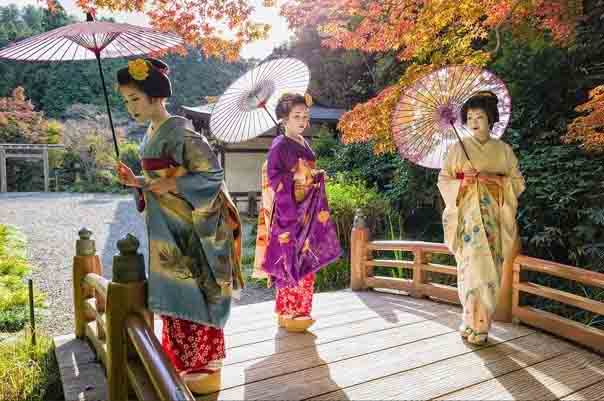Japan cultural features
The country of the rising sun attracts travelers with unique and unusual things. Aside from its gorgeous sites, Japan is also known for its vast and diversified culture. Japan, despite its reputation as an Asian country with a modern way of life, maintains its long-standing traditional cultural values.

Illustrative photo (Source: Internet).
Japanese Tea Culture
The tea culture, which first appeared around the end of the 7th century, became a type of Japanese enjoyment, a feature in Japanese culture. The Japanese tea culture developed and spread across the community, broadening their horizons.
The Japanese associate the culture of enjoying tea with the human philosophy of “hòa” – “kính” – “thanh” – “tịch” (“harmony” – “respect” – “thickness” – “virtue”). This is also the core spirit of the Japanese tea ceremony. Tea enjoyment, therefore, is not simply about drinking tea, but also enjoying and enhancing spiritual values. In which, “hòa” is peace; “kính” means respecting the superior, loving friends and children; “Thanh” is pure, pure; and “tịch” means the highest aesthetic limit of the leisurely tea ceremony.
Kimono – traditional dress
The word "kimono" in Japanese means "thing to wear" - also known as Japanese uniform. The kimono, like the Vietnamese “ao dai”, is Japan's national clothes and has been worn for hundreds of years.
Today, due to the process of international integration and the nature of living, kimono is only worn on vacations, parties, or festivals, rather than as a casual wear. In Japan, women are more likely than men to wear Kimono. In truth, there are many distinct styles of Kimono, and they will be utilized and worn in various ways to suit formal or casual situations, as well as married and single ladies. The bottom line is that all women and men fold their kimonos left first and rightmost.
Geisha - professional entertainers
It is impossible to discuss Japanese culture without mentioning geisha. This is a special example of Phu Tang's cultural beauty.
Japanese Geisha artists originally appeared in major Japanese cities around the 17th century. The unique aspect is that they are all men, rather than women as they are now. Following a time of growth, more women grew interested in becoming Geisha.
In Fukugawa, Japan, the first woman identified herself as a Geisha in 1750. This women demonstrated her singing and ability. She is also regarded as a prominent figure in Japan's Geisha tradition. Geisha culture has been strongly ingrained in Japanese society for centuries and is a favorite pastime of even visitors.
Fighting Spirit of Japan
The samurai have become a symbol of the energetic and resolute lifestyle that the Japanese strive for. This is also the spirit of Japan, showing the people's will and pride.
The traits of uprightness, courage, compassion, politeness, self-control, loyalty, and honor must be developed in order to become a true samurai. Based on these attributes, Japan, an impoverished country in East Asia that suffered greatly from the Second World War and the terrible destruction of nature, has risen to become one of the leading industrial and economic countries in the world.
Sumo in Japanese Culture
Sumo wrestler is traditional cultural symbols in Japan, and sumo wrestling is regarded as the country's national sport. In the 8th century, when it was time to plant rice, sumo bouts were performed as a way to pray for a bountiful crop or to predict whether that year's harvest would be good. The person who can take down the opponent with agility and propulsion, forcing them out of the ring, is the winner.
Popularity of Manga – Anime
If Hollywood is the Marvel movie universe, Disneyland is a little wonderland, and Manga and Anime are popular in Asia, particularly Japan. Manga is a manga series with intriguing concepts and a distinctive plot. The stories depicted in the Manga have profound cultural and spiritual elements from Phu Tang.
Anime is a subgenre of manga. Manga materials have been used into films by Japanese filmmakers, bringing characters to life with different gestures and sounds. Anime has more episodes than Manga, and the number of episodes vary depending on the author's revisions. Despite not accounting for the majority of global popularity, manga and anime have had a significant impact on contemporary Japanese society.
Greetings culture
Japanese has a unique greetings culture. Unlike Western countries, when they greet each other, they usually give a handshake, a hug or a kiss, instead of that, the Japanese show their hospitality and courtesy by bowing. This is a typical cultural features of the land of cherry blossoms.
Bowing in Japan depends on who you greet. Normally, there are 3 types of bowing. The “Eshaku” bow in which the body lightly tilted at an angle of 15 degrees is performed when you greet with your friends, company colleagues, etc. The “Keirei” bow in which the body tilted at 30 degrees is used to show your formality, courtesy when meeting someone for the first time. The “Saikeirei” bow that tilts the body at 45 degrees is required when you want to express your feelings of deep gratitude to someone giving you a warm-hearted welcome.
Take off shoes before entering house
This is the minimum politeness as well as a deeply rooted custom of Japanese culture. However, it can be difficult to distinguish if it is really necessary to take off your shoes before entering accommodations, temples or restaurants in Japan. As a result, researching some elements of this culture might help you to stay out of trouble with the shoes problem when you study or travel abroad in Japan.
You can identify whether your upcoming destination needed to take off shoes or not by observing. For example, if the shoes are placed around the entrance, it is a sign that guests should take their shoes off, and change into slippers. A Japanese house usually have a small space right after the entrance called a ‘genkan’. A genkan is a little lower than the main part of the house. It is the place where you can leave your shoes before stepping into the room.






